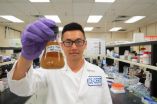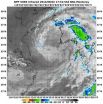(Press-News.org) RIVERSIDE, Calif. — A team of researchers, led by Professor Charles E. Wyman, at the University of California, Riverside's Bourns College of Engineering have developed a versatile, relatively non-toxic, and efficient way to convert raw agricultural and forestry residues and other plant matter, known as lignocellulosic biomass, into biofuels and chemicals.
The patent-pending method, called Co-solvent Enhanced Lignocellulosic Fractionation (CELF), brings researchers closer to solving the long elusive goal of producing fuels and chemicals from biomass at high enough yields and low enough costs to become a viable alternative or replacement for petroleum-based fuels and chemicals.
"Real estate is about location, location, location," said Wyman, the Ford Motor Company Chair in Environmental Engineering at UC Riverside's Center for Environmental Research and Technology (CE-CERT). "Successful commercialization of biofuels technology is about yield, yield, yield, and we obtained great yields with this novel technology."
The key to the UC Riverside technology is using tetrahydrofuran (THF) as a co-solvent to aid in the breakdown of raw biomass feedstocks to produce valuable primary and secondary fuel precursors at high yields at moderate temperatures.
Those fuel precursors can then be converted into ethanol, chemicals or drop-in fuels. Drop-in fuels have similar properties to conventional gasoline, jet, and diesel fuels and can be used without significant changes to vehicles or current transportation infrastructure.
Compared to other available biomass solvents, THF is well-suited for this application because it mixes homogenously with water, has a low boiling point (66 degrees Celsius) to allow for easy recovery, and can be regenerated as an end product of the process, said Charles M. Cai, a Ph.D. student working with Wyman.
CELF is unique in that it can consolidate multiple processing steps – such as pretreatment, sugar hydrolysis, and sugar catalysis – into one step. This reduces the water content of the reaction to maximize the amount of actual solids that can be loaded and also conserve heat and energy.
The process is also tunable so that different end products can be made by changing the configurations.
In a recently published paper in the journal Green Chemistry, the UC Riverside researchers showed that using CELF with highly selective acid catalysts called metal halides was particularly effective at simultaneously producing the fuel precursors furfural and 5-hydroxymethylfurfural (5-HMF) directly from raw maple wood.
Lignocellulosic biomass, which is the only sufficiently prevalent sustainable resource for conversion into liquid transportation fuels, is the most abundant organic material on Earth. It is composed of three major components: cellulose, hemicellulose and lignin.
To create precursors for drop-in biofuels, the cellulose is broken down into hydroxymethylfurfural (5-HMF) and most of the hemicellulose is broken down into furfural. The lignin is generally considered a waste product and burnt to produce energy, although that thought is changing.
Furfural and 5-HMF are widely recognized renewable chemicals for their conversion into gasoline, jet, and diesel range liquid fuels. Furfural and 5-HMF further can be further chemo-catalytically upgraded to drop-in fuels including 2-methylfuran (MF) and 2,5- dimethylfuran (DMF).
Using the combination of CELF with iron chloride, a type of metal halide, to break down the maple wood, Cai and the research team obtained yields of 95 percent of the theoretical maximum for and 51 percent for 5-HMF in a single pot reaction. This presents an improvement in yield rates of almost 50 percent over current commercial technologies and can thereby potentially reduce the cost of furfural production to within the range of current price of crude oil.
In addition to the high yield rates, more than 90 percent of the lignin was dissolved and extracted by CELF and recovered as a fine powdered product.
Lignin is often unused or burned. However, lignin is actually a promising resource for making additional high value chemicals and fuels once it is extracted and depolymerized with CELF. Because THF is easily recovered at low temperatures, its removal after the reaction allows the dissolved lignin particles to reform as solids that precipitate out of solution.
The recently published paper in Green Chemistry is titled "Coupling metal halides with a co-solvent to produce furfural and 5-HMF at high yields directly from lignocellulosic biomass as an integrated biofuels strategy." In addition to Cai and Wyman, co-authors are Nikhil Nagane, a graduate student in Wyman's lab who performed studies on reaction kinetics with CELF, and Rajeev Kumar, an assistant research engineer in Wyman's group who advises the graduate students along with Wyman.
In previous work, outlined in a 2013 paper published in Green Chemistry, Cai introduced the use of CELF with simple acids as a method to produce sugars for biological processes such as fermentation.
In this case, the technology is being employed in ongoing project at UC Riverside to combine CELF technology with microbial production of fuels, such as ethanol and butanol, by using CELF to produce highly reactive sugar-rich materials from lignocellulosic biomass that can be easily broken down to simple sugars using zero or very low levels of added enzymes.
INFORMATION:
This research is supported by the BioEnergy Science Center (BESC), Oak Ridge National Laboratory, a US Department of Energy Bioenergy Research Center supported by the Office of Biological and Environmental Research in the DOE Office of Science.
The drop-in fuels research was supported by a grant from the Sun Grant Initiative, the UC Riverside Research and Economic Development Office of Technology Commercialization, and the University of California Transportation Center.
The UCR Office of Technology Commercialization has worked with the inventors to file a patent on the invention. CELF is licensed by partners from Cognitek in Northbrook, Ill., who will be working with Cai and Wyman to create a new spin-off company to commercialize the technology.
Enhancing biofuel yields from biomass with novel new method
UC Riverside engineers develop versatile platform technology to produce biofuels more efficiently
2014-08-04
ELSE PRESS RELEASES FROM THIS DATE:
NASA catches the brief life of Tropical Storm Nakri
2014-08-04
The low pressure area known as System 96W struggled to organize for a week and finally became Tropical Storm Nakri on August 2 as the Suomi NPP satellite passed overhead. Nakri had a short life, however, as it dissipated the following day while approaching South Korea.
On Saturday, August 2, at 9 p.m. EDT, Nakri's maximum sustained winds were near 40 knots (46 mph/74 kph). At that time it was centered about 100 nautical miles southeast of Kunsan Air Base, near 35.0 north and 125.0 east. It was moving to the north at 14 knots (16.1 mph/21.9 kph).
When NASA-NOAA's Suomi ...
NASA sees Typhoon Halong's eye wink
2014-08-04
As Super Typhoon Halong tracks north through the Northwestern Pacific Ocean, NASA's Aqua and Terra satellites have seen the powerful storm appear to wink at space as it developed and "opened" an eye and then close its eye as clouds moved over it. That wink appears to be a sign of eyewall replacement in the powerful storm.
On August 2 at 01:45 UTC (August 1 at 9:45 p.m. EDT) NASA's Terra satellite captured a visible image of a wide-eyed Super Typhoon Halong moving through the Northwestern Pacific Ocean. At the time of the image, Halong was a powerful Category 5 Super Typhoon ...
No-power Wi-Fi connectivity could fuel internet of things reality
2014-08-04
Imagine a world in which your wristwatch or other wearable device communicates directly with your online profiles, storing information about your daily activities where you can best access it – all without requiring batteries. Or, battery-free sensors embedded around your home could track minute-by-minute temperature changes and send that information to your thermostat to help conserve energy.
This not-so-distant "Internet of Things" reality would extend connectivity to perhaps billions of devices. Sensors could be embedded in everyday objects to help monitor and track ...
NASA's IBEX and Voyager spacecraft drive advances in outer heliosphere research
2014-08-04
San Antonio -- Aug. 4, 2014 -- Scientists yesterday highlighted an impressive list of achievements in researching the outer heliosphere at the 40th International Committee on Space Research (COSPAR) Scientific Assembly in Moscow.
"Between NASA's Voyager and IBEX missions, it's an incredible time for outer heliospheric science," says Dr. Dave McComas, IBEX principal investigator and assistant vice president of the Space Science and Engineering Division at Southwest Research Institute, who also will be recognized with a 2014 COSPAR Space Science Award at the assembly. "Ten ...
Children in immigrant families more likely to be sedentary
2014-08-04
Immigrant children from all racial and ethnic backgrounds are more likely to be sedentary than U.S.-born white children, according to a new study by sociologists at Rice University. The researchers said their findings should remind pediatricians and parents of children in immigrant families to encourage physical activity.
The research revealed that children of immigrants from all racial and ethnic backgrounds have lower levels of physical activity than U.S.-born white children, even when adjustments are made for socio-demographic and neighborhood characteristics. A low ...
New tools advance bio-logic
2014-08-04
Researchers at Rice University and the University of Kansas Medical Center are making genetic circuits that can perform more complex tasks by swapping protein building blocks.
The modular genetic circuits engineered from parts of otherwise unrelated bacterial genomes can be set up to handle multiple chemical inputs simultaneously with a minimum of interference from their neighbors.
The work reported in the American Chemical Society journal ACS Synthetic Biology gives scientists more options as they design synthetic cells for specific tasks, such as the production of ...
GW researcher reveals how amphibians crossed continents
2014-08-04
There are more than 7,000 known species of amphibians that can be found in nearly every type of ecosystem on six continents. But there have been few attempts to understand exactly when and how frogs, toads, salamanders and caecilians have moved across the planet throughout time.
Armed with DNA sequence data, Alex Pyron, an assistant professor of biology at the George Washington University, sought to accurately piece together the 300-million-year storyline of their journey.
Dr. Pyron has succeeded in constructing a first-of-its-kind comprehensive diagram of the geographic ...
How should flood risk assessments be done in a changing climate?
2014-08-04
Growing consensus on climate and land use change means that it is reasonable to assume, at the very least, that flood levels in a region may change. Then why, ask Rosner et al. in a new study, do the dominant risk assessment techniques used to decide whether to build new flood protection infrastructure nearly always start with an assumption of "no trend" in flood behavior?
In an argument grounded in an analysis of the inherent limitations of statistical analyses, the authors suggest that researchers' typical starting assumption that flood behavior is not changing—even ...
Insights on whale shark populations and evidence for their historic rise and recent decline
2014-08-04
In the largest study on the genetics of whale sharks conducted to date, researchers found that the world's biggest fish likely exist in 2 distinct populations with minimal connectivity between the Indo-Pacific and the Atlantic Ocean. The findings suggest that mixing of whale sharks between the Indian and Atlantic was and is rare.
The Molecular Ecology investigators also found a significant and likely recent population expansion, but a very recent bottleneck might have gone undetected as genetic diversity at Ningaloo Reef in Australia has declined during 5 consecutive ...
Study assesses shark attacks on Atlantic spotted dolphins near the Bahamas
2014-08-04
A Marine Mammal Science analysis on failed shark attacks on the approximately 120 Atlantic spotted dolphins that are residents of the waters near Bimini, The Bahamas, has found that a total of 14 dolphins (15% of 92 cataloged animals) showed some sign of shark attack, and a further 15 (16%) exhibited scars that could not conclusively be classified as shark induced or not.
Of 14 the shark attacks, there was no difference in scars or wounds between the sexes, and there was no significant difference between the location of bodily scars and wounds. No shark-related injuries ...
LAST 30 PRESS RELEASES:
The Ceramic Society of Japan’s Oxoate Ceramics Research Association launches new international book project
Heart-brain connection: international study reveals the role of the vagus nerve in keeping the heart young
Researchers identify Rb1 as a predictive biomarker for a new therapeutic strategy in some breast cancers
Survey reveals ethical gaps slowing AI adoption in pediatric surgery
Stimulant ADHD medications work differently than thought
AI overestimates how smart people are, according to HSE economists
HSE researchers create genome-wide map of quadruplexes
Scientists boost cell "powerhouses" to burn more calories
Automatic label checking: The missing step in making reliable medical AI
Low daily alcohol intake linked to 50% heightened mouth cancer risk in India
American Meteorological Society announces Rick Spinrad as 2026 President-Elect
Biomass-based carbon capture spotlighted in newly released global climate webinar recording
Illuminating invisible nano pollutants: advanced bioimaging tracks the full journey of emerging nanoscale contaminants in living systems
How does age affect recovery from spinal cord injury?
Novel AI tool offers prognosis for patients with head and neck cancer
Fathers’ microplastic exposure tied to their children’s metabolic problems
Research validates laboratory model for studying high-grade serous ovarian cancer
SIR 2026 delivers transformative breakthroughs in minimally invasive medicine to improve patient care
Stem Cell Reports most downloaded papers of 2025 highlight the breadth and impact of stem cell research
Oxford-led study estimates NHS spends around 3% of its primary and secondary care budget on the health impacts of heat and cold in England
A researcher’s long quest leads to a smart composite breakthrough
Urban wild bees act as “microbial sensors” of city health.
New study finds where you live affects recovery after a hip fracture
Forecasting the impact of fully automated vehicle adoption on US road traffic injuries
Alcohol-related hospitalizations from 2016 to 2022
Semaglutide and hospitalizations in patients with obesity and established cardiovascular disease
Researchers ‘listen in’ to embryo-mother interactions during implantation using a culture system replicating the womb lining
How changing your diet could help save the world
How to make AI truly scalable and reliable for real-time traffic assignment?
Beyond fragmented markets: A new framework for efficient and stable ride-pooling
[Press-News.org] Enhancing biofuel yields from biomass with novel new methodUC Riverside engineers develop versatile platform technology to produce biofuels more efficiently







